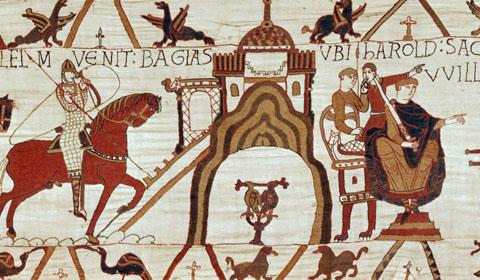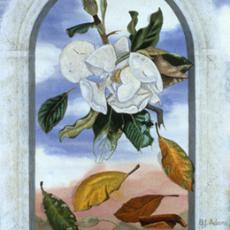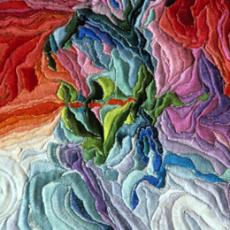
DOUG JOHNSON: I'm Doug Johnson.
FAITH LAPIDUS: And I'm Faith Lapidus with EXPLORATIONS in VOA Special English. At craft shows and corporate headquarters across the United States, you might see works by the artist B.J. Adams. She makes extremely detailed wall coverings that often show flowers, trees, and hands made from thread.
Her work "Variations on H" is made up of different colors of finely made hands connected together to form a flowing cloth. How did Ms Adams make this work? Today we answer this question as we explore the world of textile art.
(MUSIC)
DOUG JOHNSON: For thousands of years, people have developed creative ways to produce textiles. A textile is a piece of cloth that has been formed by weaving, knitting, pressing or knotting together individual pieces of fiber. Yarn is a general term for long pieces of interlocked fibers. Yarn can be made from natural materials such as cotton, linen, silk and wool. Or it can be made from manufactured materials such as nylon, acrylic and polyester. The paints that give color to yarn are called dyes.
Many people today might not think much about the shirt, pants, or socks they are wearing. Manufacturing cloth is now a very low cost process. But this was not always the case.
FAITH LAPIDUS: Until the 19th century, all cloth was made by hand. It took a great deal of time and effort to gather fibers from plants or animals to make into yarn which could then be made into cloth. Humans probably first made textiles to meet important needs. These include textiles for keeping warm, creating shelter, and holding goods. But cultures around the world also developed methods of making cloth that were artistic, creative, and beautiful.
Weaving is one way to produce cloth. A set of threads called the warp form the base of the cloth. Other threads called the weft are placed over and under the warp. The device used to weave together warp and weft threads is called a loom. If you look down at a piece of fabric as though it were a map, the warp threads would go in a north-south direction. The weft goes in an east-west direction.

DOUG JOHNSON: A tapestry is a special kind of weaving method in which the weft does not go continuously through the whole width of the fabric. A weaver uses the weft threads to create individual areas of color. The designs and images on the surface of a tapestry are woven into the cloth as opposed to being only on the surface of the cloth.
Some famous examples of wall tapestries were produced in Europe, starting around the 14th century. These include the seven Unicorn Tapestries that are part of the collection of the Metropolitan Museum of Art in New York City.
These extraordinarily fine tapestries were made in the early 16th century. They were thought to have been designed in Paris and woven in Brussels, then part of the Netherlands. They are so detailed they look more like paintings than weavings. The textiles tell a story about a group of hunters and wealthy people searching for a magical creature. During this period, wealthy people used finely made tapestries to bring color and warmth to their large houses.
FAITH LAPIDUS: Kilims are a kind of tapestry made across North Africa, the Middle East, Turkey and the Caucasus. Kilims were often made by tribes that moved from place to place. Kilims were made to cover the floors of tents or to hold goods. In these nomadic cultures, women were usually the weavers. A mother would pass down weaving traditions to her daughter. Kilims are woven with many bright patterns and complex geometric forms. Each tribe or area has its own kilim traditions.
Another method for making floor coverings involves tying pieces of yarn onto the warp. Unlike kilims, these "pile" carpets are not flat, they are deep and soft because their surfaces are covered with the ends of thousands of pieces of yarn. These carpets are often called "Oriental" or "Persian" carpets. The National Gallery in Washington, DC has several fine examples of pile carpets from Iran. One red and gold carpet from the seventeenth century has complex patterns and animal designs.
DOUG JOHNSON: There are more methods for producing artistic textiles than we have time to discuss. For example, in the United States the tradition of making quilts has a long and rich history. Quilts are made by piecing together layers of cloth to make colorful coverings. The Amish religious group is well known for their inventive and bold quilt patterns.
There also many different ways to change the appearance of the surface of a textile. Embroidery work involves using colored yarn and a needle to create designs on the surface of cloth. One famous example of embroidery work is called the Bayeux Tapestry. This eleventh century work is not actually a tapestry. It is a 70 meter long cloth covered in embroidery stitches.
The images sewn on the cloth tell about the events leading up to the Norman invasion of England in 1066. The work includes hundreds of soldiers, horses, boats, and weapons.
There are also many methods for coloring fabrics with dyes. In Indonesia, the batik method of dying fabric involves using wax to make complex patterns. In Japan, the shibori method involves tieing cloth in different ways so that some areas of it receive the dye. What kind of textile traditions exist where you live?
(MUSIC)
FAITH LAPIDUS: These textile traditions are ancient. Modern artists use these methods and others in creative and inventive ways to make new and exciting work. Artists who make art from textiles are often called fiber artists. We visited the studio of B.J. Adams in Washington, DC to see a fiber artist at work.
B.J. Adams uses a sewing machine and thread like a painter uses color. She guides the cloth she is working on so that the machine makes stitches and slowly colors the work. This is called free-motion embroidery.
B.J. ADAMS: "I started out with drawing and painting in school. And, I always made all my own clothes. And one time, in 1960, I started to see contemporary embroidery. And I'd never seen any embroidery except what the Girl Scouts showed you. And it was so good and so interesting, I thought it was combining two things I love, art and sewing."
DOUG JOHNSON: Ms Adams is always testing new ideas and methods. For example, she recently used heat transfers to copy images of paintings she made years ago onto cloth. Usually, she will cover the lines of her drawings using a straight stitch on her sewing machine. But for this series, she is experimenting with a zig-zag stitch that looks like a line made up of angles.
B.J. ADAMS: "I'm doing the whole thing in zig-zag. Just trying something new."
(SOUND)
FAITH LAPIDUS: Many of her works are influenced by nature, trees, and flowers. Some have a dreamy, surreal look. Others are very realistic. One work shows a large embroidered white magnolia flower sewn onto a painted surface. It is so detailed that unless you look up close, you would think it was a painting.
B.J. ADAMS: "This is one from my drawings of the magnolia, which we have in our backyard. The magnolias die so quickly when you bring them in, so I had to draw it quickly before I started in on the stitching."

FAITH LAPIDUS: Below the flower, Ms Adams embroidered leaves in a range of colors to show how they change as they dry.
B.J. ADAMS: "They started out this kind of dark kelly and then they go to yellow, green, and brown and end up this color down here. It's called "Catching the Moment" because they die so quickly."
DOUG JOHNSON: Many works by B.J. Adams are abstract. This means there is no image, just an arrangement of forms and colors. One series is based on her time teaching in New Zealand. She used very dense stitches that are very close together to make flowing lines of bright colors.
B.J. ADAMS: "Now that one and this one are both results of bungee jumping in Queenstown. And that's called "Bungee Attitude" and that's called "Rebound."
FAITH LAPIDUS: Other works are influenced by gallery shows that have a set theme.
B.J. ADAMS: "This one is "Variations on K", because this is the word kiss in every language, including sign language. And it was made for a show that had the theme of kiss. And they required this size piece, so that was the one I created."

DOUG JOHNSON: Earlier, we discussed the work "Variations on H." It hangs on a window in her colorful studio. It is made up of about 40 drawings of Ms Adams' hands. She made each hand as an example to students while she was teaching a class on drawing using free-motion embroidery. She decided to piece together the hands into one work.
B.J. Adams sewed the drawings onto special fabric which melted away after she washed it. What is left is pure embroidery. This complex work honors the artist's most important tool, her hands. And, it gives a good example of the endless creative possibilities of fiber art.
(MUSIC)
FAITH LAPIDUS: This program was written and produced by Dana Demange. I'm ---Faith Lapidus.
DOUG JOHNSON: And I'm -----Doug Johnson. You can see pictures of B.J. Adams' fiber art on our Web site, voaspecialenglish.com. Join us again next week for Explorations in VOA Special English.
yarn: a continuous twisted strand of natural or synthetic fibres, used in weaving, knitting, etc. 紗線
acrylic: short for acrylic fibre, acrylic resin 丙烯酸纖維;腈綸
polyester: any of a large class of synthetic materials that are polymers containing recurring -COO- groups: used as plastics, textile fibres, and adhesives 聚酯纖維
warp: the threads that run lengthwise in a woven fabric, crossed at right angles to the woof 經紗
weft: the horizontal threads interlaced through the warp in a woven fabric; woof 緯紗
loom: an apparatus for making thread or yarn into cloth by weaving strands together at right angles 織布機
tapestry: a heavy cloth woven with rich, often varicolored designs or scenes, usually hung on walls for decoration and sometimes used to cover furniture 掛毯;織錦
kilim: a tapestry-woven Turkish rug or other textile with geometric designs in rich, brilliant colors (產于土耳其、高加索一帶的)基里姆地毯
quilt:a thick warm cover for a bed, consisting of a soft filling sewn between two layers of material, usually with crisscross seams 棉被
embroidery: decorative needlework done usually on loosely woven cloth or canvas, often being a picture or pattern 刺繡
batik: a process of printing fabric in which parts not to be dyed are covered by wax 蠟染
magnolia: any tree or shrub of the magnoliaceous genus Magnolia of Asia and North America: cultivated for their white, pink, purple, or yellow showy flowers 木蘭;玉蘭類的植物
Getting a feel for textile arts around the world
(來源:VOA 編輯:張若瓊)
